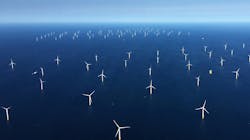Study warns of energy losses connected to larger offshore wind turbines
Offshore staff
GOLDEN, COLORADO — ArcVera Renewables claims that energy losses from offshore wind plants caused by long-distance wakes are much greater than expected.
Using high-fidelity long-range wake loss modeling, the company’s study at the New York Bight offshore development sites found that commonly used engineering wake models under-predict energy losses due to external wakes. It called for more research into the phenomenon.
The study found that velocity deficits of up to 1 m/s, or 10%, persist up to or beyond 100 km downwind of large offshore arrays. This leads to long-range energy deficits that are above what most specialists employed by the industry have expected.
ArcVera uses the Weather Research and Forecasting (WRF) model and for this project added the Wind Farm Parameterization (WFP) to the model to account for the effects of the wind turbines in the domain.
CEO Greg Poulos said, “This new study provides an important cautionary lesson as the wind industry proceeds to ever-larger wind turbine models with greater farm density across the globe.
“WRF-WFP’s results here show that engineering wake or WFAI models currently under-predict long-range wake losses by a significant margin. Unexpected losses are likely to accrue from wind farms once thought to be too far away to be material to project performance.”
ArcVera consulted with Professor Julie Lundquist’s research group at the University of Colorado concerning the uncertainty in these model predictions of large, long-range wakes. Tests of sensitivity to model configuration parameters confirmed that the above results produced the weakest wakes of all the configurations tested.
According to the company, the engineering models typically used by the industry to estimate wakes have been validated for internal wakes and nearby external wakes, but have not been validated regularly at such long distances. Nor have they been validated at all for large nameplate (> 12 MW) and rotor diameter (> 200 m) wind turbines.
However, for an onshore case study in Iowa, the WFP in WRF was validated against SCADA recorded production, the company said, and was also accurate with respect to long-distance wakes within 16% at a 5-km (50 rotor diameter) range.
This tool is used to reduce risk and optimize wind farm design.
In the onshore validation study, wakes were found to travel more than 40 km overland in stable atmospheric conditions, said Mark Stoelinga, who heads Atmospheric Science Innovation at ArcVera.
“Over the ocean, it is common for atmospheric stability to be enhanced, especially when warm air flow passes over colder underlying water," Stoelinga said. "We also surmise that the very large turbines used in the study produce unusually strong wakes that cannot easily recover their lost momentum, especially under enhanced atmospheric stability conditions.”
An example of waked wind speed deficit from the WRF-WFP simulations is shown in the figure above. The left panel shows the effect of turbines in only the Southern Array, whereas the right panel shows the effect of turbines in both the Southern and Central Arrays.
The dominant feature of these plots is the long-range project-scale wake swath extending from the arrays to the north-northeast. Even at the northern edge of the domain, over 100 km downwind of the Southern Array, the long-range wake from the Southern Array only (left panel) maintains a 0.7 m/s (or 7%) hub-height wind speed deficit; and 80 km downwind of the Central Array, the long-range wake from the Southern and Central Arrays combined (right panel) maintains a 1.0 m/s (or 10%) wind speed deficit.
The waked speed deficits within the target (0538, Northern) array are 1.6 m/s (16%) from the Southern Array only, and 2.5 m/s (25%) from the combination of the Southern and Central Arrays. Note that no turbines from the Northern Array were included in the simulations, so the entire speed deficit within the Northern array is due to external wakes from the Southern and Central Arrays.
Read the full study at ArcVera White Paper Estimating Long-Range External Wake Losses WRF-WFP 1.0.
08.16.2022

